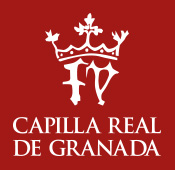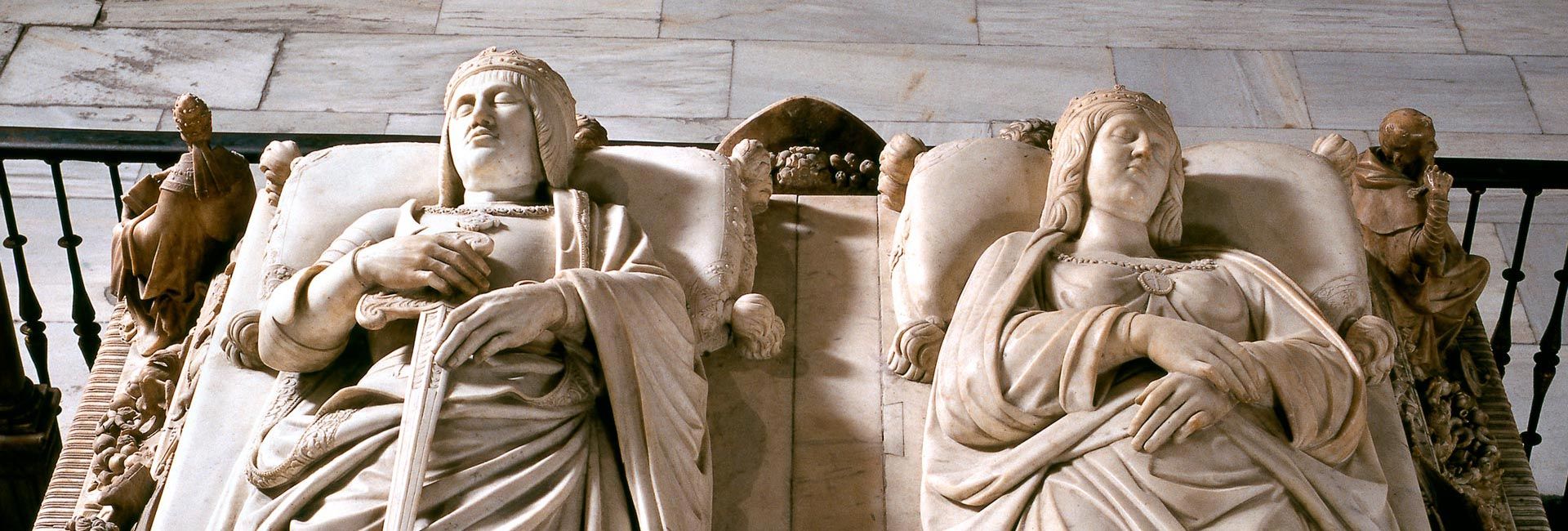FIVE HUNDRED YEARS OF HISTORY
On the 13th of September of 1504, Queen Isabella and King Ferdinand decided that Granada would be their final resting place, and to this end they signed a Royal Warrant for the creation of the Royal Chapel. A new burial place brought about the construction, decoration, and furnishing of the building. Furthermore, it involved the creation of an institution with people working for that place, the provision of funds and, finally, the establishment of the appropiate legal rights in order to guarantee its welfare. These are the basis to consolidate symbols and messages and this is the meaning of the Royal Chapel of Granada, built in Gothic style between 1505-1517 and dedicated to Saint John the Baptist and Saint John the Evangelist.
The small history of the Chapel reflects the great history of Spain, the history of the church and the mirror of the artistic and cultural evolution. The Chapel was built in the Gothic style between 1505 and 1517. The Queen died one year before the starting of the edification of the site and the King died one year before the work was completed. During this time, the Royal Chapel already existed as an institution with a Main Chaplain and twelve chaplains. Meanwhile, the Chapel was decorated and it received the precious legacy from the Founders Monarchs: paintings, relics, books, tapestries and fabrics, vestments, and liturgical vases.
The XVI century constitutes the golden age of the Royal Chapel; during this period, we can distinguish three stages: its birth shortly before the death of Queen Isabella and its construction during the reign of King Ferdinand. You can feel the Medieval spirit which brings out the sobriety of the buiding and of the institution itself; and furthermore, we cannot forget that it was the Queen’s wish to be buried «dressed in the habit of the blessed pauper of Christ, St. Francis». The second stage means the flowering with Emperor Charles I. The temple is decorated and the institution is strengthened. It means the end of a dinasty, the appearance of the Renaissance, the humanist demonstration of such an impressive historic heroic deed. The end with Philip II: although he maintained and consolidated the legacy, his initiatives were not supported and then, he pursued other goals. El Escorial and Simancas are now his future projects and, consequently, half of the royal remains and the Chapel’s book collection were moved there.
During the first half of the XVII century the Chapel was not innovated. It was the prelude of the coming decadence which would last the whole century and the first half of the XVIII century. Now, when we observe the Chapel, we can find new treasures from both periods. The temple is decorated in a Baroque taste. Apart from the artistic changes, the institution is undergoing a serious economic crisis which results in constant cutbacks in the workforce, both for chaplains and for other workers.
Halfway through the XVIII century, the Chapel underwent a new resurgement. Ferdinand VI understood the original sense of the foundation and was determined to recover it, with such an aim he ordained in the new ordinances: «to restore as far as possible the decline of my Royal Chapel in Granada together with the goods pertaining thereto, so that a more dignified memory of the Lords the Catholic Kings, the glorious founders of the Chapel, shall be retained».

The end of the 18th and the first half of the 19th centuries caused new problems to the institution. They were associated to political changes, financial difficulties and to the deep changes in the church-state relationship. The liberal regime put an end to the Church council regime and, finally, to the original foundations of the institution. From that moment on, the institution became an exclusively ecclesiastical body. To this should be added the aging of the building.
The Concordat of 1851 followed by a Royal decree establishing a reorganization of the royal chapels brought a certain stability. Elizabeth II, who visited the chapel in 1862, gave a boost to a new regulation. With the Restoration a new balance is achieved and an increased interest in historical research, artistic restoration and museums is developed. This way becomes evident since the IV centenary of the surrender of Granada and the discovery of America. The first scientific publications on the Chapel and its cultural heritage date from this period.
During the 20th century the historiographical, artistic, archivistical as well as musical interest for the Royal Chapel grows. A Chapter Museum is created in 1913 by Royal Decree. Meanwhile, there is an increasing tourism, new researches are carried out, and the spiritual significance of the chapel for hispanic awareness is emphasized. The Concordat of 1953 does not change the established regulations for the chapel in 1851. However, from the middle of the 20th century, the chapel gained more interest. There is more tourism and more researches on the Chapel are carried out. These facts together with the exhibition abroad of some of the pieces of art, being the Flemish painting collection particularly appreciated, support the international projection of the chapel.
During the last years, continuous works of restoration both in the chapel and in its heritage are being made. The most remarkable are the new remodeling of the Lonja and the Sacristy-Museum and the restoration of the main altarpiece. The Consejería de Cultura de la Junta de Andalucía ( Board of culture of Andalucia), and the Fundación CAJA MADRID have collaborated in these works, and thanks to their generous contributions and those coming from other private and public institutions, the constant investment of the Chapter of the Royal Chapel has been completed. With a view to the V Centenary of Queen Isabella’s death new works are being prepared: the restoration of the main grille, the tombs of the kings and the paraments, among others.
Today, the Chapel is an important image of the church and of the urban landscape of Granada and this can be testified by its numerous visitors, some attracted by its tourist interest, others by its historical significance, trying to find a sense and value.source; among the latter, we can find many Hispanic people from both sides of the Atlantic ocean. The figure of the Catholic Queen causes a great interest and gives a spiritual sense to the visit of the Chapel. The Chapter, which serves the Chapel, is aware of the great historic, artistic and religious heritage which has been received and is trying to maintain, enhance and transmit it.



